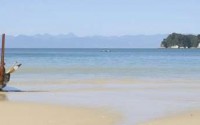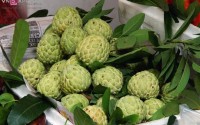Where to drink in Vietnam
At Audley, our specialists have local knowledge about the top vietnam places to visit. Find out where we recommend for your next tailor-made trip.
Giai khat means “quench your thirst” and you’ll see the signs everywhere, on stands selling fresh juices, bottled cold drinks or outside cafés and bia hoi (draught beer) outlets. Many drinks are served with ice: tempting though it may be, the only really safe policy is to avoid ice altogether – dung bo da, cam on (“no ice, thanks”) should do the trick. That said, ice in the top hotels, bars and restaurants is generally reliable, and some people take the risk in less salubrious establishments with apparent impunity.
Water and soft drinks
Tap water is not safe to drink in Vietnam – since bottled water is both cheap and widely available, you shouldn’t need to take the risk anyway. Avoid drinks with ice or those that may have been diluted with suspect water.
Locally made soft drinks are tooth-numbingly sweet, but are cheap and safe – as long as the bottle or carton appears well sealed – and on sale just about everywhere. The Coke, Sprite and Fanta hegemony also means you can find fizzy drinks in surprisingly remote areas. Oddly, canned drinks are usually more expensive than the equivalent-sized bottle, whether it’s a soft drink or beer – apparently it’s less chic to drink from the old-fashioned bottle.
A more effective thirst-quencher is fresh coconut juice, though this is more difficult to find in the north. Fresh juices such as orange and lime are also delicious – just make sure they haven’t been mixed with tap water. Sugar-cane juice (mia da) is safer, since it’s pressed right in front of you. Pasteurized milk, produced by Vinamilk, is now sold in the main towns and cities.
Somewhere between a drink and a snack, ché is made from taro flour and green bean, and served over ice with chunks of fruit, coloured jellies and even sweet corn or potato. In hot weather it provides a refreshing sugar-fix.
Tea and coffee
Tea drinking is part of the social ritual in Vietnam. Small cups of refreshing, strong, green tea are presented to all guests or visitors: water is well boiled and safe to drink, as long as the cup itself is clean, and it’s considered rude not to take at least a sip. Although your cup will be continually replenished to show hospitality, you don’t have to carry on drinking; the polite way to decline a refill is to place your hand over the cup when your host is about to replenish it. Green tea is also served at the end of every restaurant meal, particularly in the south, and usually provided free.
Coffee production has boomed in recent years, largely for export, with serious environmental and social consequences. The Vietnamese drink coffee very strong and in small quantities, with a large dollop of condensed milk at the bottom of the cup. Traditionally, coffee is filtered at the table by means of a small dripper balanced over the cup or glass, which sometimes sits in a bowl of hot water to keep it warm. However, places accustomed to tourists increasingly run to fresh (pasteurized) milk, while in the main cities you’ll now find fancy Western-style cafés turning out decent lattes and cappuccinos. Highland Coffee has become Vietnam’s very own Starbucks-style chain, while out in the sticks you’re best off going for cafés with a Trung Nguyen sign.
Alcoholic drinks
In Vietnam, drinking alcohol is a social activity to be shared with friends. You’ll rarely see the Vietnamese drinking alone and never without eating. Be prepared for lots of toasts to health, wealth and happiness, and no doubt to international understanding, too. It’s the custom to fill the glasses of your fellow guests; someone else will fill yours.
Canned and bottled beers brewed under licence in Vietnam include Tiger, Heineken, Carlsberg and San Miguel, but there are also plenty of very drinkable – and cheaper – local beers around, such as Halida, 333 (Ba Ba Ba) and Bivina. Some connoisseurs rate Bière la Rue from Da Nang tops, though Saigon Export, Hanoi Beer and BGI are also fine brews, It’s where Nguyen Thai Hoc street, near temple of literature. Many other towns boast their own local beers, such as Hué (where the main brand is Huda), Hai Phong and Thanh Hoa (where it’s simply named after the town) – all worth a try.
Roughly forty years ago technology for making bia hoi (draught beer) was introduced from Czechoslovakia and it is now quaffed in vast quantities, particularly in the north. Bia hoi may taste fairly weak, but it measures in at up to four percent alcohol. It’s also ridiculously cheap – between 2500? and 5000? a glass – and supposedly unadulterated with chemicals, so in theory you’re less likely to get a hangover. Bia hoi has a 24-hour shelf life, which means the better places sell out by early evening, and that you’re unlikely to be drinking it into the wee hours. In the south, you’re more likely to be drinking bia tuoi (“fresh” beer), a close relation of bia hoi but served from pressurized barrels. Outlets are usually open at lunchtime, and then again in the evening from 5pm to 9pm.
Wine (the conventional kind) is becoming increasingly popular in Vietnam – even in small towns, you’ll easily track some down, and imported bottles continue to crop up in the most unexpected places. Local production dates from the French era, and is centred around Da Lat – the main producer is Vang Da Lat, bottles of which will cost from 50,000? in a shop, and 70,000? at a restaurant. Only at top hotels, restaurants or specialist shops will you find decent imported bottles that have been properly stored; you’ll be paying premium prices for these.
Read more: A comprehensive list of what to do in hanoi, Vietnam. Includes all the major sights and activities in and around Hanoi.





